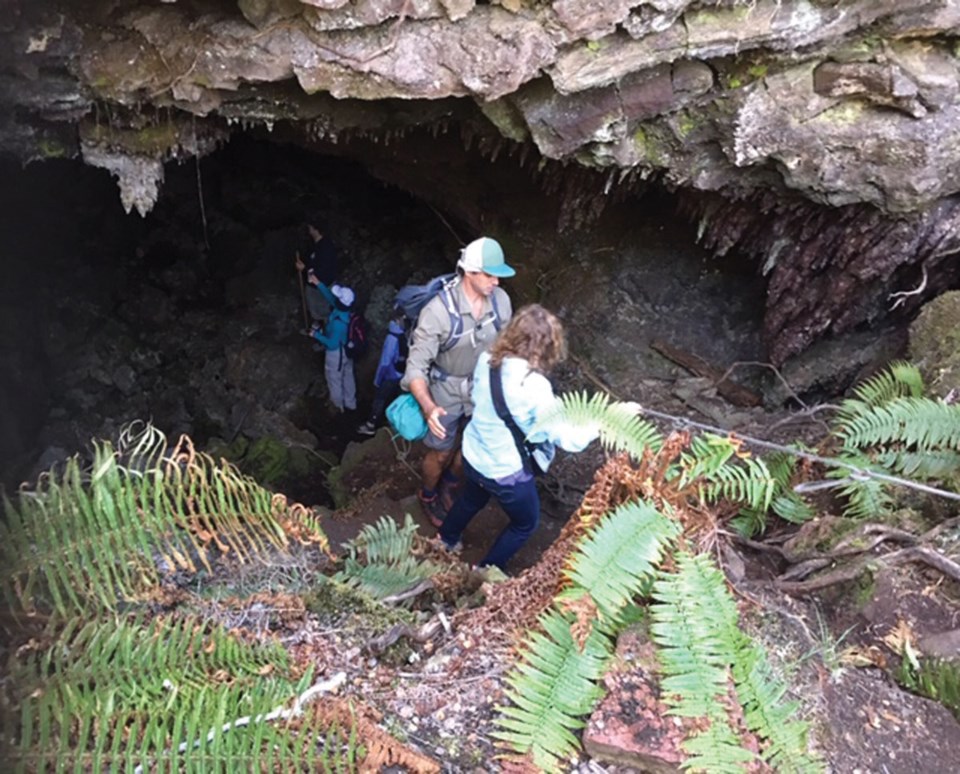Above Kona, Hualalai volcano beckons! So boarding a comfortable Hawaii Forest and Trails van, we travel up-country past coffee estates and homes bounded by huge tropical plants. Further up, feral chickens dart from borders of red ti plants, blossoming orange ginger and lacy tree ferns.
“Eight centuries ago, Polynesians brought this jungle fowl,” guide Taj remarks. “You’ve likely seen later introduced birds at your resorts: yellow saffron finch, Java sparrows, common mynahs and red Brazilian cardinals. Most of Hawaii’s indigenous plants and animals live at the highest elevations.”
Veering onto a gravel road, Taj stops to unlock a gate and drives into a rugged fenced area. Our group of ten piles out amid some gnarly shrubs and trees. To protect these critically important and endangered ohia, we brush and sanitize our shoes. We reboard, and the van bumps and grinds on through two more gates.
Parking in a large clearing, Taj distributes bamboo hiking sticks, water, snack bars, rain ponchos and shoulder packs. Scrambling up a slope, we view a huge volcanic fissure and sweeping panorama. Taj points out Maui’s distant Haleaka crater, Hawaii’s northern Kohala crater and Kona’s dramatic lava-strewn coastline.
“The Island of Hawaii’s five shield volcanoes lie dormant after 35 years of eruption. Hualalai last erupted in 1801,” Taj smiles. “Volcanoes typically sleep for 200 years. Listen … anyone hear a rumble?”
Advancing toward a grove of Koa tress, five bright red i’ivi fly overhead. Awed by this rare sighting, Taj tells us these beauties’ long beaks draw nectar from the ohia’s scarlet blossoms. Our trail leads us over crunchy black lava covered with silvery green lichen.
A spidery organism drapes numerous ohias. “Non-parasitic, lichens are harmless, symbiotic organisms of algae and fungus,” Taj explains. “As protection, they’ve developed silver filaments filtering dangerous ultraviolet light.”
Taj explains the nature of our pathway. We pass between numerous little green bushes spiked with branches of colourful dangling berries; Hawaiian birds thrive on them. Endemic geese called nene prefer purple berries. Hawaiians fondly named its bush the purple goose poop plant. Though seldom seen, red ‘apane chirp melodically in the forest canopy. Their repertoire contains over 300 songs. Beside a trailside fern, feral pigs had evidently rooted up a meal. Brought in canoes, we learn they now far outnumber human islanders.
Our group soon arrives at a lava tube. A francolin, a large brown game bird from India, greets us above its entrance. “Blazing magma forms these lava tubes,” Taj tells us. “It freezes after contacting much cooler surface air. Frozen upper layers insulate the lava’s flow. These tubes can extend over 20 miles, and collapsed layers create skylights.”
This skylight entrance resembles an enormous snake’s mouth baring a row of stalactite fangs. Rappelling into its rocky throat, we pass through its gullet. Midway, another skylight illuminates our short, serpentine route around fallen jagged rocks. Scrambling over blocks of basalt, we ultimately exit onto another well-marked trail.
Smooth pahoehoe lava paves much of our upward path to Hulalalai’s largest crater and 2,000-metre summit. Black, grey and rusty red streaky layers recall its fiery past. Once holding a molten lake, its cauldron now sleeps. Skirting the rim downward, our route encounters a smaller crater, where new growth thrives on rich volcanic soils. Back aboard the van, we roll down to Kailua to visit Kona’s newest brewery.
Touring its modern facilities, we learn Ola Brew produces a unique range of beverages based on locally farmed fruits and grains. We sample delightful lagers and an IPA featuring grapefruit. Ciders from dragon fruit, passion fruit and white pineapple further quench our thirst. It’s a tasty conclusion to this Big Island adventure!
To plan your trip, see www.hawaii-forest.com



